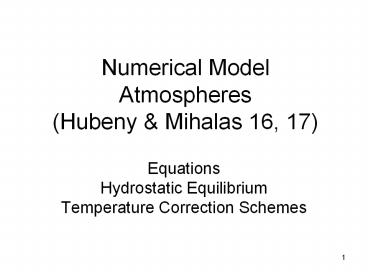Numerical Model Atmospheres (Hubeny - PowerPoint PPT Presentation
Title:
Numerical Model Atmospheres (Hubeny
Description:
Based primarily upon temperature and electron density. Given abundances, ne, T we can find ... Column Density. Rewrite H.E. using column mass inwards (measured ... – PowerPoint PPT presentation
Number of Views:17
Avg rating:3.0/5.0
Title: Numerical Model Atmospheres (Hubeny
1
Numerical Model Atmospheres (Hubeny Mihalas
16, 17)
- EquationsHydrostatic EquilibriumTemperature
Correction Schemes
2
Summary Basic Equations
Equation CorrespondingState Parameter
Radiative transfer Mean intensities, J?
Radiative equilibrium Temperature, T
Hydrostatic equilibrium Total particle density, N
Statistical equilibrium Populations, ni
Charge conservation Electron density, ne
3
Physical State
- Recall rate equations that link the populations
in each ionization/excitation state - Based primarily upon temperature and electron
density - Given abundances, ne, T we can find N, Pg, and ?
- With these state variables, we can calculate the
gas opacity as a function of frequency
4
Hydrostatic Equilibrium
- Gravitational force inward is balanced by the
pressure gradient outwards, - Pressure may have several components gas,
radiation, turbulence, magnetic - µ atomic mass units / free particle in gas
5
Column Density
- Rewrite H.E. using column mass inwards (measured
in g/cm2), RHOX in ATLAS - Solution for constant T, µ (scale height)
6
Gas Pressure Gradient
- Ignoring turbulence and magnetic fields
- Radiation pressure acts against gravity
(important in O-stars, supergiants)
7
Temperature Relations
- If we knew T(m) and P(m) then we could get ?(m)
(gas law) and then find ?? and ?? - Then solve the transfer equation for the
radiative field (S? ?? / ?? ) - But normally we start with T(t) not T(m)
- Since dm -? dz dt? / ?? we can transform
results to an optical depth scale by considering
the opacity
8
ATLAS Approach (Kurucz)
- H.E.
- Start at top and estimate opacity ? from adopted
gas pressure and temperature - At next optical depth step down,
- Recalculate ? for mean between optical depth
steps, then iterate to convergence - Move down to next depth point and repeat
9
Temperature Distributions
- If we have a good T(t) relation, then model is
complete T(t) ? P(t) ? ?(t) ? radiation field - However, usually first guess for T(t) will not
satisfy flux conservation at every depth point - Use temperature correction schemes based upon
radiative equilibrium
10
Solar Temperature Relation
- From Eddington-Barbier (limb darkening)
t0 t(5000 Å)
11
Rescaling for Other Stars
Reasonable starting approximation
12
Temperature Relations for Supergiants
- Differences smalldespite very different length
scales
13
Other Effects on T(t)
Including line opacity or line blanketing
Convection
14
Temperature Correction Schemes
- The temperature correction need not be very
accurate, because successive iterations of the
model remove small errors. It should be
emphasized that the criterion for judging the
effectiveness of a temperature correction scheme
is the total amount of computer time needed to
calculate a model. Mathematical rigor is
irrelevant. Any empirically derived tricks for
speeding convergence are completely
justified.(R. L. Kurucz)
15
Some T Correction Methods
- ? iteration scheme
- Not too good at depth (cf. gray case)
16
Some T Correction Methods
- Unsöld-Lucy methodsimilar to gray case find
corrections to the source function Planck
function that keep flux conserved (good for LTE,
not non-LTE) - Avrett and Krook method (ATLAS)develop
perturbation equations for both T and t at
discrete points (important for upper and lower
depths, respectively) interpolate back to
standard t grid at end (useful even when
convection carries a significant fraction of flux)
17
Some T Correction Methods
- Auer Mihalas (1969, ApJ, 158, 641)
linearization method build in ?T correction in
Feautrier method - Matrices more complicated
- Solve for intensities then update ?T































